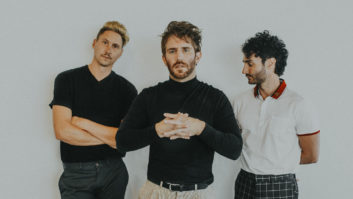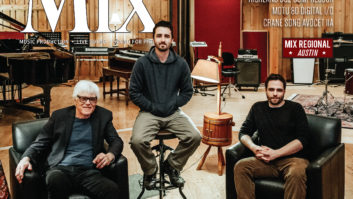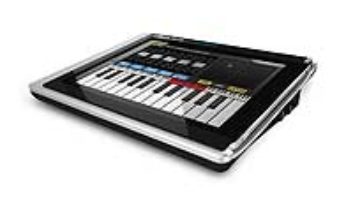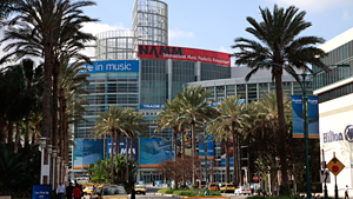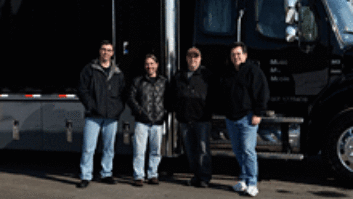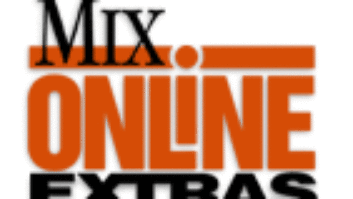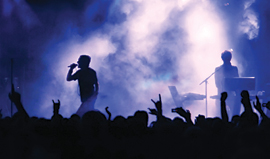
Photo: Shutterstock.com/©DWPhotos
It’s almost impossible to exaggerate the pandemic effect that plunging record sales and low-cost recording technology have had on recording facilities and engineers. Location recording professionals who have survived the loss of their traditional live album business have adapted their offerings to suit an industry in which the small laptop-based live recording system has become an unlikely competitor. Smaller secondary trucks and high-end portable rigs, along with expanded post-production services, now support the “big rigs,” which, by the way, still handle plenty of big jobs.
To David May, VP of DVD audio and video production for Warner Bros. and Rhino Records, professional audio trucks remain an absolute necessity. “We have a huge volume of work going on — we did about 160 DVDs last year, several of which involved live concert recordings for accompanying CDs,” May says. “It’s an old joke that sound is always the last consideration when it comes to producing films or television, but we’re a record company, and when we’re shooting a concert for DVD and TV sound is just as important, if not more so, as the visual.”
Indeed, location recording mainstays such as Karen Brinton and David Hewitt’s Remote Recording Services, Randy Ezratty’s Effanel/Sirius XM Productions, Guy Charbonneau’s Le Mobile, Kooster McAllister’s Record Plant Remote and Guillaume Bengle’s Studio Mobile bring a quality assurance to producers like May, whose jobs may not only hinge on fiscal responsibility, but also depend on quality product at the end of the day. Some bands may hook up a Pro Tools rig to the digital console at front of house or rely on the video truck’s audio booth or touring personnel to record a concert, but this is risky business, fraught with many possible pitfalls.
“Live recording is high-pressure — you only get one shot,” says Larry Hamby, Sony/BMG senior VP of A&R, Commercial Music Group. “By the time I want to hire a professional recording truck, there’s already an imperative in a project — it’s usually an expensive, high-pressure project with a lot of commercial demands built into it, so you really don’t want to blow it. You want as much of a safety net as possible, and by appealing to the best in the business that’s what you get.”
Much like the biggest and best recording studios, the best in the mobile recording business face the difficult challenge of justifying their existence to the new wave of clients, many of whom are trying to achieve greatness on a shoestring budget. “Instead of the band management or record label comparing our bid with a bid from one of our competitors, they’re comparing it to how much it would cost to plug a laptop in at FOH,” says Brinton, owner and manager of Remote Recording. “It’s comparing apples and oranges. I’ve had clients who’ve wanted to use us and been overruled, and then had to deal with the aftermath when the computer at FOH lost the signal and they ended up with no audio.”
May has used small portable rigs when the budget is just not there for a truck, but will hire a qualified crew to capture the show. As most of the mobile recording specialists do offer smaller vehicles or portable solutions, relying on a totally makeshift rig or a laptop recording off the board seems foolhardy in a one-night-only situation. “I did a show in Los Angeles recently where four bands were performing, two of which I was responsible for recording,” says May. “I told the production company for the other two bands that I was hiring Le Mobile and offered that if they used the truck as well, we would all save money. They said their budget was too tight; they were just going to record from FOH. Halfway through their first band, they realized they were getting no signal and they ended up with no audio except the mix CD from FOH.”
That other producer might have opted for Le Mobile’s more economical 48-track portable system, which features Pro Tools HD with Apogee converters and Grace Design preamps, as well as a backup hard drive, UPS power, a full splitter, intercom system and timecode generator. “It’s a real system and will be operated by a real engineer [namely, Ian Charbonneau] who knows about mic placement and crowd-miking,” says Le Mobile owner/operator Charbonneau. “If you were to lose power, you’d have 20 minutes of backup power for your system while you find the source of the failure.”
Hamby adds, “People are watching money everywhere in this economy, but there are other ways to skin that cat — I’m not going to compromise when it comes to the recording if the product is audio.”
NEW DIRECTIONS
Selling Effanel Music to XM Satellite Radio (now Sirius XM) in 2005 was Ezratty’s way of adapting his business to the changes he saw happening in the industry. “I saw a tightening up of the business model: A lot of bands were beginning to record themselves and smaller companies were popping up as the technology became so obtainable,” he explains. “It was pretty analogous to what was happening in the studio world. The client base for Effanel was changing, and it was companies like XM and Sirius and the big television networks who were becoming our bread-and-butter clients.”
In the past few years, operating as XM Productions though still a service-for-hire, Ezratty notes, “The major uptick in our business has come from festivals — we do Bonnaroo, Lollapalooza and Austin City Limits.”
The large-scale technical capabilities of a professional audio truck and the seen-it-all experience of the engineers onboard are integral to a huge music festival being covered by several multiplatform media outlets. Ezratty explains, “We go to Bonnaroo, for example, as a stand-alone recording company, and while our feed happens to be going out on XM that is not the main thrust of the gig. Each stage has nonstop coverage, and we become a central clearinghouse of audio and video for all the stages — whatever outlets have made arrangements for picking up any act at any given time, it’s all there waiting for them. AT&T Blueroom, for example, had a live Webcast going off a few of the stages, and Fuse was covering the show, as well.”
Charbonneau handles the massive Coachella festival each spring, bringing his main Pro Tools HD3 and Neve 8058-equipped truck and that 48-track portable recording system to work two stages, while Gary Ladinsky’s Design FX and Seattle Recording capture the other two. “We’ve done a Webcast for the past three years, which Hank Neuberger [of Springboard Productions] produces, so each site has to feed a live mix to the Webcast,” notes Charbonneau. “I am in charge of all the audio and supply all the drives to the various outlets, plus I’ll pull and mix the music for the festival DVD.”
Le Mobile’s main business is concert DVDs, and Charbonneau is building facilities to handle post-production for these projects. “I’m building a nice control room where my Pro Tools engineer, Anthony Catalano, can work post-show,” he says. “It will have a 60-inch TV screen, surround monitoring array, and we will welcome video editors to bring their Final Cut systems in there, so Le Mobile will be a complex. I can offer clients a package deal between the services of my truck and an editing and post-production suite.”
Post-production is also a growth area for Sirius XM/Effanel, according to Ezratty. “We were working on post-production for the U2 3D film for IMAX for over a year, in our studios at Jazz at Lincoln Center. The band recorded it with their system on the road, but there was still a lot of post-production revenue to be had.”
Music television, concert specials and American Idol–spawned reality programming have created regular business for location-recording trucks such as Ringwood, N.J.–based Record Plant Remote and Le Studio Mobile in Montréal. Last year, McAllister built a new Record Plant Remote truck, which is parked in Nashville, where he records and mixes the weekly series Nashville Star live-to-air for NBC.
“Ninety-eight percent of my work now is for television or DVD,” McAllister says. “For the larger shows I’ve worked on — Nashville Star for NBC, Can You Duet for CMT and Decades for VH1 — grabbing something from the FOH mix is not an option because you have to make sure your interface is with timecode and word clock, and that you’re able to provide everything the video truck needs. When you’re mixing something live to air, you need someone that’s paying attention specifically to that mix for TV.”
McAllister built the new Record Plant Remote truck to suit the direction he sees his business heading. “I designed the new truck specifically for what’s needed on these TV programs: ease of interface, quick setup and everything being recallable at the quick push of a button,” he says. “There are other trucks in the U.S. using the same basic format — Yamaha DM2000s with a fiber-optic system — but one thing that sets me apart is that I can do 96 inputs to 96 tracks at 96 kHz [recording to four Tascam X48s, providing 96 redundant tracks]. A lot of the trucks have a bottleneck with the fiber system, where it will only allow them to record at 48k, and I’ve successfully alleviated that bottleneck.”
McAllister’s original API truck does the Good Morning America summer concert series in New York City’s Bryant Park, which recently drew 10,000 for an 8 a.m. Miley Cyrus performance. “Having the two trucks has been great because it’s given me the two places to strike from,” says McAllister, “though it seems, these days, I have more work in Nashville than anywhere.”
Guillaume Bengle recently introduced Le Studio Mobile “Version 2.0” in the form of a brand-new recording truck, equipped with two Yamaha DM2000V2 digital production consoles, 24-bit/96kHz, cascaded and fully automated, for a total of 192 channels. Bengle also records to Tascam X48s and Steinberg Nuendo, and a Sony PCM 800 48-track recorder rounds out the system so that Studio Mobile can provide 72 redundant tracks. “I really feel I’ve built a truck for our times,” says Bengle, who records the Montréal Jazz Festival and recently recorded Paul McCartney performing a free concert for 200,000 in Quebec City for Pay-Per-View.
“The timing of the new truck and all aspects of the design and equipment choices have been really good,” Bengle notes. “Most of my market is in Canada — the big networks like CTV, CBC and TVA. But I’m also going to the U.S. more than I used to. Often, if it’s a short enough distance, I can drive the truck myself and hire local engineers. Inside the truck, I have everything I need to do these shows. I did the finale of The Apprentice in New York City and the Billboard Latin Music Awards down in Miami.”
Bengle feels the producers who choose a laptop-based recording system over a truck or a professionally assembled and manned portable system may end up hitting a wall. “Oftentimes, a customer will do some kind of temporary system and it ends up costing him more money than if he’d just hired me,” he comments. “They don’t realize how much trouble it is and how much time it takes away from what they need to concentrate on — the music. A customer came back to me recently, saying they’d tried to do it themselves and the audio guy had nothing on the hard drive after the show. So they come back.”
In 2006, Remote Recording introduced a second truck, which is also equipped with two DM2000V2 consoles, with a pair of 128-track AMD 64-bit dual-processor Nuendo systems and a 96-track Pro Tools system. Brinton reports that the new “White Truck,” which is half as long as the original Neve-equipped “Silver Truck,” handles about half of the gigs that Remote Recording books. “The White Truck has helped us expand our clientele and have more versatility. Having two trucks really helps in this volatile business climate, where all the bookings seem to come at the same time, and then very little will be going on at other times.”
Both Remote Recording trucks, for example, have worked at the Metropolitan Opera this year, on shows that go out live in HD to Regal Cinemas and are captured, edited and posted for broadcast on PBS. “Either truck can handle it, but the Met went digital this year and there’s one show we’re doing in the upcoming season that has around 140 inputs, so they’ve specifically requested the digital truck for that for a more seamless production.”
Remote has also beefed up the Silver Truck to 96 inputs, and Brinton notes that she still has a core group of clients who will only work in the Silver Truck with its analog Neve VRM console. “At the end of last year, we recorded Neil Young to 2-inch tape, so analog recording still comes up sometimes,” she adds, “though typically we’re going to Pro Tools HD with a Nuendo backup.”
NEW BUSINESS
Just like the stationary studio market, mobile recording businesses succeed on reputation and relationships. Even in tough economic conditions, the right combination of people and technology can be successful. On June 1, engineers Joel Singer, John Harris and Jay Vicari, and producer Mitch Maketansky launched a brand-new mobile recording company, Music Mix Mobile, and right out of the gate handled the Billy Joel concerts at Shea Stadium and Hershey Park, Bon Jovi in Central Park, and shows for Coldplay and Rush. The new truck, called M3, has an all Grace Design front end (112 Grace mic pre’s), Pro Tools HD6 and HD5 systems, and 32-fader Digidesign D-Control, with a Genelec 8200 DSP monitoring system. According to Singer, it also boasts one of the largest selections of plug-ins available in the U.S.
“We are recording on two of the largest Pro Tools recorders in any remote truck in the world right now,” reports Singer. “They’re capable of recording 144 inputs, and we’ve done it already — over 112 inputs for the Billy Joel concerts.” On bringing a new truck into the market, Singer replies, “There are new clients out there, people who want to take projects from beginning to end in more cost-effective ways and we are set up to do that.”
Music Mix Mobile also offers flight-pack systems and a post-production facility, located in New Jersey, where Harris and Vicari remix projects. “We can set up our flight-pack systems in the back of our Sprinter truck if necessary, which we did for The Cure at Madison Square Garden for the Fuse Network,” Singer describes. “We then went out to Denver and recorded three nights of the theater show 3 Mo’ Divas, which we’re also remixing in 5.1 for a PBS HDNet broadcast with the same flight pack — very space- and cost-effective for the client.”
Indeed, HDTV paves another way for the ongoing need for true mobile recording specialists, as the imminent transition in February ’09 to all-digital TV is sure to bring an increase in hi-def programming and the networks will need hi-def content. “HDTV will expose everything, and as there’s more and more HD channels, I definitely think there’s going to be more of a need for high-quality audio production,” May asserts. “The qualified people are out there, and we’re set to do it — we all have to be fiscally responsible without compromising the quality of the content.”
Janice Brown is a freelance writer based in New York City.
